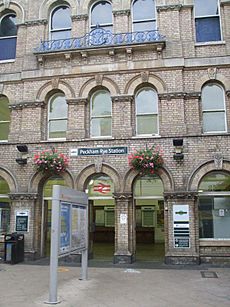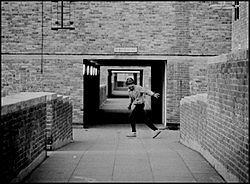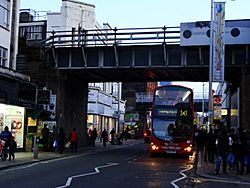Peckham facts for kids
Quick facts for kids Peckham |
|
|---|---|
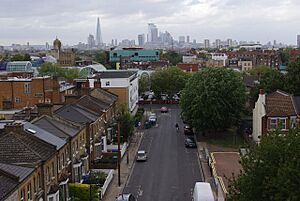 View from Cerise Road in Peckham with the City visible in the background, 2019 |
|
| Population | 71,552 (Peckham, Peckham Rye, Nunhead, Livesey and The Lane wards 2011) |
| OS grid reference | TQ345765 |
| London borough | |
| Ceremonial county | Greater London |
| Region | |
| Country | England |
| Sovereign state | United Kingdom |
| Post town | LONDON |
| Postcode district | SE15 |
| Dialling code | 020 |
| Police | Metropolitan |
| Fire | London |
| Ambulance | London |
| EU Parliament | London |
| UK Parliament | |
| London Assembly |
|
Peckham (/ˈpɛkəm/ PEK-əm) is a lively area in south-east London. It is part of the London Borough of Southwark. Peckham is about 5.6 kilometers (3.5 miles) south-east of Charing Cross, a central point in London. In 2001, the Peckham area had a population of 14,720 people.
Contents
History of Peckham
Early Times and the River Peck
The name "Peckham" comes from the Saxons. It means "the village of the River Peck". This was a small stream that flowed through the area. The river was covered over in 1823.
Before the Saxons, there is proof that Romans lived here. However, we do not know the name of their settlement.
Peckham is mentioned in the Domesday Book of 1086. This was a big survey of England ordered by William the Conqueror. At that time, Peckham was called Pecheham. It was owned by the Bishop of Lisieux.
Royal Connections and a Famous Fair
Later, King Henry I owned the land. He gave it to his son, Robert, Earl of Gloucester. When Robert married the heiress to Camberwell, the two areas became united under the King.
It is believed that King John used to hunt in Peckham. Local stories say he gave the area the right to hold an annual fair. This was to celebrate a really good day of hunting. The fair became very popular and lasted three weeks. It was known for being quite rowdy until it was stopped in 1827.
Growth and Gardens
By the 1500s, Peckham became a popular place for wealthy people to live. Some even say that the famous architect Christopher Wren had connections here. In the 1700s, Peckham became more of a business hub. Industrialists moved here to avoid the high costs of central London.
Peckham was also famous for its large market gardens and orchards. They grew fruits and vegetables for London's markets. Things like melons, figs, and grapes grew here. The beautiful gardens of the Peckham Manor House were rebuilt in 1672. You can see them on an old map from 1746. The manor house was later destroyed in 1688. It was finally pulled down in 1797 to make way for new streets.
Drovers and Brick Makers
Peckham was the last stop for many drovers. These were people who moved cattle to London for sale. The drovers would stay in local inns, like the Red Cow. The cattle were kept safe overnight in pens. Most people in Peckham worked in farming. But as the area grew, more people worked in the brick industry. This was because of the local London Clay.
In 1767, the poet William Blake visited Peckham Rye. He said he saw an angel in a tree there. In 1993, an artist painted a mural of Blake's vision. It is next to the Goose Green playground in East Dulwich.
The 19th Century: Transport and Shopping
At the start of the 1800s, Peckham was a "small, quiet village surrounded by fields." Stagecoaches had to travel with armed guards. This was to protect against highwaymen. The roads were rough, so a canal was planned. It would go from the Thames to Portsmouth. The Grand Surrey Canal was built to Peckham, but money ran out in 1826. The canal was used to ship wood. Even though it was filled in 1970, a timber merchant still stands there today.
In 1851, Thomas Tilling started a new omnibus service from Peckham to London. His buses were the first to use planned bus stops. This helped them run on time. His company grew across London.
Before Peckham Rye railway station opened in 1865, Peckham had two main parts: north and south. In the north, houses spread south of the Old Kent Road. In the south, large houses were built near the open land called Peckham Rye.
With the railway and horse-drawn trams, Peckham became easy to reach. Many office workers and skilled craftspeople moved here. New housing filled almost all the fields, except for Peckham Rye. In 1868, the local council bought Peckham Rye. They wanted to keep it as common land for everyone. Later, they bought a nearby farm and opened it as Peckham Rye Park in 1894.
With more people and money, Rye Lane became a major shopping street. Jones & Higgins opened a small shop in 1867. It grew into a famous department store in South London. It closed in the 1980s. In 1870, George Gibson Bussey started a firearms business in Peckham. There was even a Museum of Firearms with a rifle range.
The late 1800s also saw George Batty, a condiment maker, set up shop. His company's Peckham site used 19 railway arches. H. J. Heinz Company bought it in 1905. It was their first factory in the UK.
The southern part of Peckham had a railway line. It once went to the Crystal Palace in Sydenham. The line was later removed. You can still see parts of its route today.
Near here is the Aquarias Golf Club. It sits above the huge Honor Oak Reservoir. This was built between 1901 and 1909. When it was finished, it was the largest underground brick reservoir in the world. It is still one of the biggest in Europe.
Camberwell Old Cemetery opened to help with crowded churchyards. This happened as London grew quickly in the 1800s. The Stone House at its entrance was used in a film. It was later damaged by fire and rebuilt.
The 20th Century: Health and Change
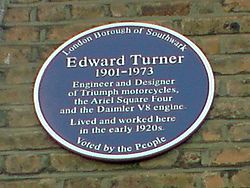
In the 1930s, George Scott Williamson and Innes Pearse opened the Pioneer Health Centre. They wanted to study how the environment affects health. This was called 'The Peckham Experiment'. About 950 families joined for a small weekly fee. Members could use sports facilities, workshops, and social areas. The centre moved into a special building in 1935.
North Peckham was rebuilt a lot in the 1960s. Many tall apartment buildings were put up. This was to rehouse people from older, run-down homes. At first, these new homes were popular. But later, many people lost their jobs. This led to the area facing challenges. The North Peckham Estate became one of the most challenged residential areas in Western Europe. It saw a lot of damage and crime. Because of this, a big project started in the late 1990s to improve the area.
In the early 1990s, Peckham was a hub for underground music. This was partly due to a large squat called The Dolehouse. It was in a disused building near Peckham High Street.
Peckham was one of the areas where protests and disturbances happened during the 2011 England riots.
Peckham Today
Since the 1990s, the European Union has helped to improve Peckham. They helped fund the amazing Peckham Library, which has won awards. They also helped create a new town square and new homes. Money is still being used to improve houses and streets. This includes public art projects, like the mosaics by Tom Phillips.
In 1994, the Peckham Arch was finished. It was designed by architects Troughton McAslan. There are plans to take down the arch to build new apartments. This decision was made despite public protests.
The main shopping street in Peckham is Rye Lane. The large Peckham Rye Park is also nearby. Bellenden Road is an area with many small, independent shops.
Culture and People
Peckham has never been a single official district. But it developed a strong identity in the 1800s. Rye Lane was one of the most important shopping streets in south London. The area is now seen as one of the 35 major centres in Greater London.
Peckham is a large area with many different communities. The British Nigerian community is a big part of the population. Some people even call the area "Little Lagos." In 2011, about 5,250 people born in Nigeria lived in the whole Peckham area.
Peckham has a mix of traditional London working-class people. It also has communities from the Caribbean, China, India, Ghana, Zimbabwe, Nigeria, Somalia, Pakistan, Bangladesh, Turkey, Eastern Europe, and Vietnam.
Recently, some parts of south Peckham have seen "gentrification". This means that new cafes, wine bars, special shops, and artists' studios have opened.
Who Lives in Peckham?
Peckham is one of the most diverse places in the UK. Here are the ethnic groups in the Peckham ward, based on the 2011 Census. This ward is only about one-fifth of the whole Peckham area. So, it might not show the full picture for all of Peckham.
- Black African – 35.67%
- White British – 25.73%
- Black Caribbean – 15.45%
- Other White – 4.58%
- Other Black – 3.58%
- East Asian – 3.51%
- Other Asian – 2.14%
- Irish – 1.93%
- Mixed White-Black Caribbean – 1.86%
- Bangladeshi – 1.25%
- Other Mixed – 1.17%
- Mixed White-Black African – 1.08%
- Indian – 0.69%
- Other South Asian – 0.68%
- Mixed White-South Asian – 0.35%
- Pakistani – 0.33%
Peckham in Books and TV
- Muriel Spark's novel The Ballad of Peckham Rye (1960) is set in the area.
- The TV show Only Fools and Horses (1981-2003) was set in Peckham. Its spin-off, Rock & Chips, was also set there in the 1960s.
- The TV comedies Desmond's and Porkpie were filmed and set in Peckham.
- Other comedies like Meet the Adebanjos and The Tboy Show were also set in Peckham.
- A 30-minute musical called We The Ragamuffin was filmed in Peckham. It was shown on Channel 4 in 1992.
- The character Rose Tyler from Doctor Who lived in a fictional flat in Peckham.
- The E4 show Youngers is filmed and set in Peckham.
- In the TV series Foyle's War, a character becomes a Member of Parliament for 'West Peckham'.
- Four characters in Bernardine Evaristo's novel Girl, Woman, Other are linked to a fictional Peckham school.
- The film Rye Lane is mostly set in Peckham. It features real places like Rye Lane Market and the Peckhamplex cinema.
- Key scenes in the 2023 film Love at First Sight happen at the fictional Peckham House.
Famous People from Peckham
Many well-known people have connections to Peckham:
- John Boyega, actor and producer
- Rio Ferdinand, English footballer
- Claire Foy, actress, lived in Peckham for several years
- Julius Francis, boxing champion
- Giggs, rapper
- Damson Idris, actor and producer
- Naira Marley, Afro-pop artiste
- Kye Whyte, BMX racing Olympic silver medalist
- King Krule was raised between Peckham and East Dulwich
- SL, rapper
- Cosmo Pyke, singer-songwriter
- Ashley Walters, actor and rapper
- Susan Wokoma, actor, writer, director
- Alan Lancaster, founder, bassist-vocalist for Status Quo
- Mary Phillip, English footballer
Getting Around Peckham
Nearby Areas
- Bermondsey
- New Cross
- Camberwell
- East Dulwich
- Nunhead
- Brockley
- Walworth
- Rotherhithe
Train Stations
Peckham does not have a London Underground (Tube) station yet. But a new Tube station is planned for the Bakerloo line extension. It will be on Asylum Road, northeast of central Peckham. It will be between Burgess Park and New Cross Gate.
Current train stations in the area are:
- Peckham Rye railway station
- Queens Road Peckham railway station
- Nunhead railway station
Bus Services
Peckham bus garage is run by London Central. It is on Blackpool Road. It opened in 1994. It replaced an older, larger bus garage on Peckham High Street.
Images for kids
-
View from Cerise Road in Peckham with the City visible in the background, 2019
-
London Borough of Southwark Blue Plaque awarded to famous motorbike designer Edward Turner unveiled in 2009 at his former residence, 8 Philip Walk, Peckham. Turner had run a motorbike shop, Chepstow Motors on Peckham High Street.
See also
 In Spanish: Peckham para niños
In Spanish: Peckham para niños



